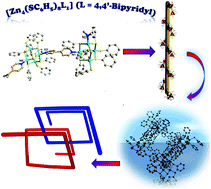Construction of a series of zero-dimensional/one-dimensional crystalline Zn–S clusters – effect of the character of bridging organic ligands on structural diversity†
Abstract
A series of chalcogenide compounds with various compositions, i.e., octanuclear or tetranuclear Zn–S clusters, have been synthesised in a straighforward manner. Different fused-ring aromatic ligands were used as capping ligands and the corresponding zero-dimensional (0D) products were obtained. On the other hand, use of bridging ligands led to a family of one-dimensional (1D) coordination polymers, and an in situ ligand reaction has been observed in [Zn8S(SC6H5)13L1(H2O)]·2H2O (L = 3-carboxypryidyl) due to the hydrolysis of the cyano group of 3-pyridinecarbonitrile. A very rare 1D helical-chain structure was observed in [Zn4(SC6H5)8L1] (L = 4,4′-bipyridyl), providing evidence of the character of bridging organic ligands in the corresponding crystalline materials. First-principles calculations on [Zn4(SC6H5)8L1] (L = 4,4′-bipyridyl) further revealed that the two cluster units could rotate freely about the C–C single bond over a broad range, eventually leading to the formation of a one-dimensional helical structure.


 Please wait while we load your content...
Please wait while we load your content...